Golden Retrievers are beloved family companions, but like many large dog breeds, they’re unfortunately prone to developing tumors throughout their lives. Understanding what does a tumor look like on a dog and recognizing tumor symptoms in dogs can be life-saving knowledge for Golden Retriever owners. This comprehensive guide will help you identify potential tumors, understand the various types, recognize the signs of cancer in dogs and tumor symptoms in dogs, and know when to seek immediate veterinary care.
Contents
- 1 Understanding Dog Tumors: The Basics Every Golden Retriever Owner Should Know
- 2 Visual Identification: What Does a Tumor Look Like on a Dog?
- 3 Types of Tumors Common in Golden Retrievers
- 4 Diagnosis and Professional Evaluation
- 5 Treatment Options and Prognosis
- 6 Prevention and Early Detection Strategies
- 7 Foods and Dietary Considerations
- 8 Precautions and Safety Measures
- 9 Emergency Situations: When to Seek Immediate Care
- 9.1 Critical Symptoms:
- 9.2 Emergency Protocols:
- 9.3 What does a cancerous tumor look like on a Golden Retriever?
- 9.4 How quickly do tumors grow in Golden Retrievers?
- 9.5 Can I tell if my Golden Retriever’s tumor is benign or malignant just by looking?
- 9.6 Are Golden Retrievers more prone to certain types of tumors?
- 9.7 Should I be worried about every lump I find on my Golden Retriever?
- 9.8 What’s the difference between a tumor and a cyst in dogs?
- 9.9 At what age should I start worrying about tumors in my Golden Retriever?
- 9.10 How often should I check my Golden Retriever for tumors?
- 10 Final Thoughts
Understanding Dog Tumors: The Basics Every Golden Retriever Owner Should Know
Tumors in dogs are abnormal growths of cells that can appear anywhere on or inside your Golden Retriever’s body. These growths can be benign (non-cancerous) or malignant (cancerous), and early detection is crucial for successful treatment outcomes.
Golden Retrievers have a higher predisposition to certain types of cancer, including hemangiosarcoma, lymphoma, and osteosarcoma. According to veterinary oncologists, approximately 60% of Golden Retrievers will develop cancer during their lifetime, making it essential for owners to understand what does a tumor look like on a dog.
Common Tumor Locations in Golden Retrievers
Tumors can develop virtually anywhere on your Golden Retriever’s body, but some locations are more common than others:
- Skin and subcutaneous tissue – Most visible and easily detected
- Lymph nodes – Often felt as swollen lumps under the jaw, in the armpits, or groin area
- Mammary glands – Particularly in unspayed females
- Mouth and oral cavity – Can affect eating and breathing
- Internal organs – Spleen, liver, and other organs (harder to detect early).
Visual Identification: What Does a Tumor Look Like on a Dog?
Size and Shape:
- Tumors can range from pea-sized to several inches in diameter.
- May be round, oval, or irregularly shaped.
- Can be flat against the skin or raised and protruding.
- Some tumors grow rapidly while others develop slowly over months.
External Tumor Appearance
When examining your Golden Retriever for potential tumors, you’ll want to look for several visual characteristics that can help identify abnormal growths:
Color Variations:
- Skin tumors may appear pink, red, black, or the same color as surrounding skin.
- Some tumors may have a mottled or multicolored appearance.
- Ulcerated tumors often appear raw and red.
- Melanomas typically appear dark brown or black.
Texture and Consistency:
- Soft and squishy (often lipomas or fatty tumors).
- Hard and firm (possibly more concerning growths).
- Rough or smooth surface texture.
- Some may feel warm to the touch due to increased blood flow.
Tumor Symptoms in Dogs: Beyond Visual Appearance
While knowing what does a tumor look like on a dog is important, recognizing tumor symptoms in dogs goes beyond visual identification. Golden Retrievers may exhibit various behavioral and physical changes when tumors are present:
Physical Symptoms:
- Visible lumps or bumps on the skin.
- Swelling in specific body areas.
- Changes in appetite or difficulty eating.
- Unexplained weight loss or gain.
- Labored breathing or coughing.
- Limping or difficulty moving.
Behavioral Changes:
- Decreased energy or lethargy.
- Reluctance to exercise or play.
- Changes in bathroom habits.
- Increased sleeping or hiding behavior.
- Irritability or changes in temperament.
Types of Tumors Common in Golden Retrievers
Benign Tumors
Lipomas (Fatty Tumors):
- Soft, moveable lumps under the skin.
- Usually painless and slow-growing.
- Most common in older Golden Retrievers.
- Generally not dangerous, but should be monitored.
Sebaceous Cysts:
- Small, round bumps that may leak fluid.
- They often have a dark center or opening.
- Can become infected if not properly managed.
- Usually benign but may require removal if problematic.
Malignant Tumors
Mast Cell Tumors:
- Can appear as raised, ulcerated, or hair-loss patches.
- May change size rapidly.
- Often itchy, causing dogs to scratch excessively.
- Require immediate veterinary attention.
Melanomas:
- Dark-colored growths, often black or brown.
- Can appear anywhere, but commonly in the mouth or on toes.
- Highly aggressive if malignant.
- Early detection and treatment are crucial.
Hemangiosarcoma:
- Often internal tumors affecting the spleen or heart.
- May cause sudden weakness or collapse.
- External versions appear as dark, blood-filled masses.
- Tumor symptoms in dogs
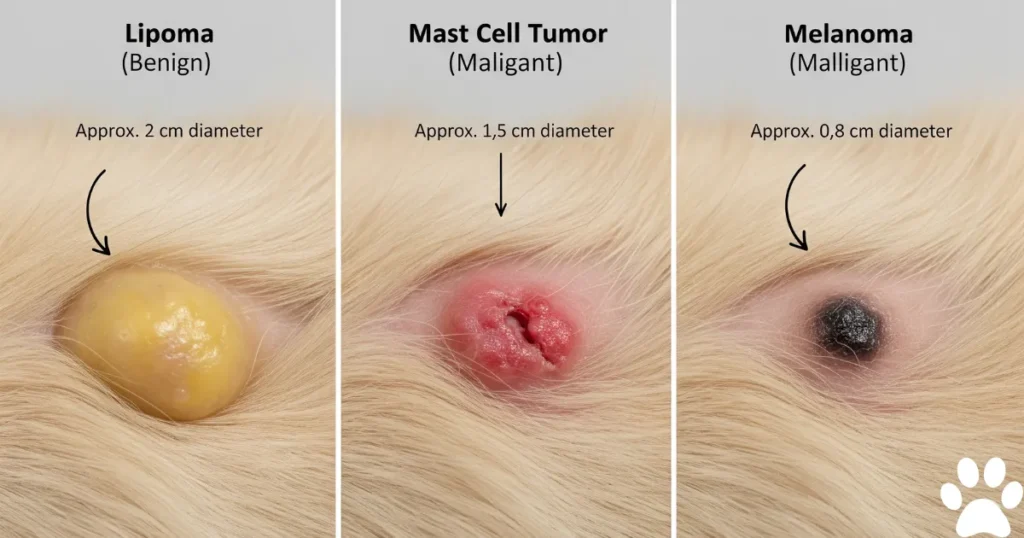
Diagnosis and Professional Evaluation
When to Consult Your Veterinarian
Any new lump or bump on your Golden Retriever warrants professional evaluation. However, certain characteristics require immediate attention:
- Rapidly growing masses.
- Ulcerated or bleeding tumors.
- Tumors that interfere with normal functions.
- Multiple new growths are appearing simultaneously.
- Any growth accompanied by other symptoms.
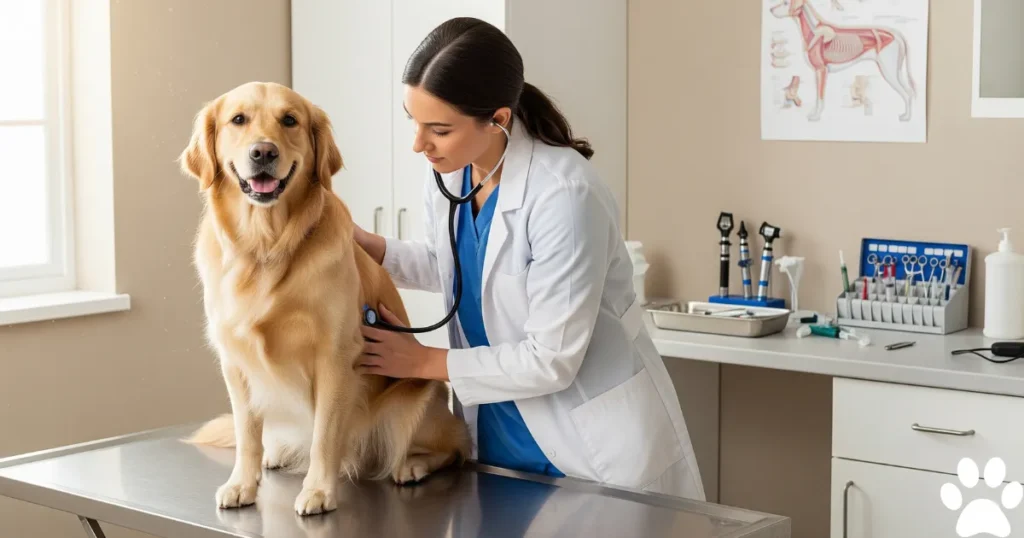
Diagnostic Procedures
Fine Needle Aspiration:
- Quick, minimally invasive procedure.
- Provides initial information about cell types.
- Helps determine if further testing is needed.
- It can often be done during a regular appointment.
Biopsy:
- More definitive diagnostic tool.
- Provides detailed information about tumor type and grade.
- May require sedation or anesthesia.
- Essential for developing appropriate treatment plans.
Advanced Imaging:
- X-rays, ultrasounds, or CT scans.
- Help identify internal tumors.
- Determine the extent of tumor spread.
- Guide surgical planning when necessary.
Treatment Options and Prognosis
Surgical Intervention
Surgery remains the primary treatment for most tumors in Golden Retrievers. The success of surgical treatment depends on several factors:
- Tumor location and size.
- Type of tumor (benign vs. malignant).
- Stage of cancer is malignant.
- Overall health of your Golden Retriever.
Surgical Considerations:
- Complete removal with clean margins is ideal.
- Some tumors may require extensive surgery.
- Recovery time varies based on procedure complexity.
- Post-surgical monitoring is essential.
Medical Treatments
Chemotherapy:
- Used for certain cancer types.
- May be recommended after surgery.
- Generally well-tolerated in dogs.
- Requires regular monitoring and follow-up.
Radiation Therapy:
- Effective for some tumor types.
- Often used when complete surgical removal isn’t possible.
- Requires specialized veterinary facilities.
- May be combined with other treatments.
Prognosis Factors
The prognosis for Golden Retrievers with tumors varies significantly based on multiple factors:
- Early detection and treatment.
- Tumor type and grade.
- Location and extent of the tumor.
- Age and overall health of the dog.
- Response to treatment.
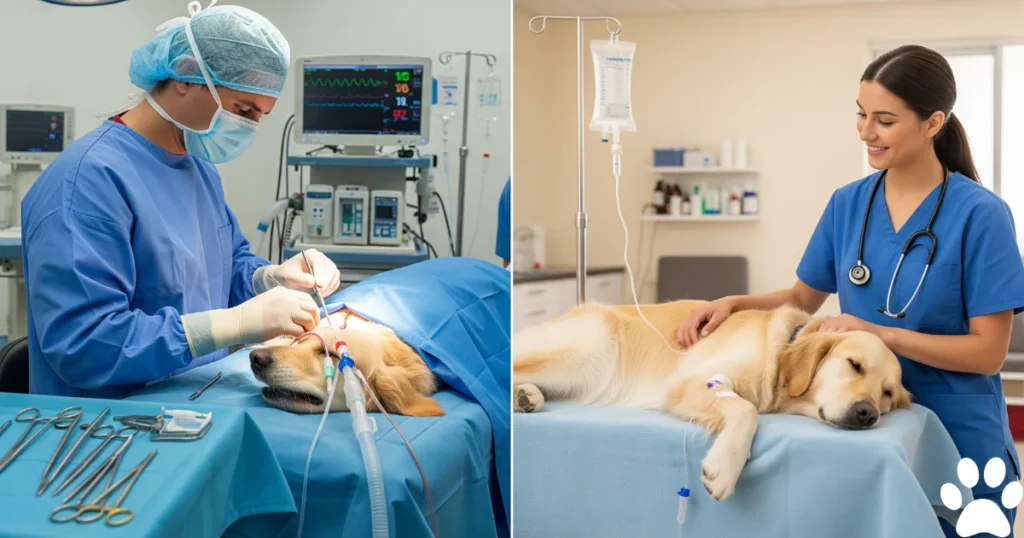
Prevention and Early Detection Strategies
Regular Health Monitoring
Monthly At-Home Examinations:
- Run your hands over your Golden Retriever’s entire body.
- Pay special attention to areas where lumps commonly develop.
- Document any new findings with photos if possible.
- Note changes in size, color, or texture of existing growths.
Professional Veterinary Checkups:
- Schedule regular wellness examinations every 6-12 months.
- Older Golden Retrievers may benefit from more frequent visits.
- Discuss any concerns or changes you’ve noticed.
- Ensure your veterinarian performs thorough physical examinations.
Lifestyle Factors.
Nutrition and Weight Management:
- Maintain a healthy weight to reduce cancer risk.
- Provide high-quality, balanced nutrition.
- Consider antioxidant-rich foods.
- Avoid exposure to known carcinogens when possible.
Exercise and Activity:
- Regular exercise supports immune system function.
- Helps maintain a healthy weight.
- Provides opportunities for physical examination during grooming.
- Promotes overall well-being and quality of life.

Foods and Dietary Considerations
Cancer-Fighting Foods for Golden Retrievers
While diet alone can not prevent or cure cancer, certain foods may support your Golden Retriever’s immune system and overall health:
Antioxidant-Rich Options:
- Blueberries (in moderation).
- Sweet potatoes.
- Leafy green vegetables.
- Fish rich in omega-3 fatty acids.
Foods to Avoid:
- Processed foods with artificial preservatives.
- Excessive treats or table scraps.
- Foods high in sugar or simple carbohydrates.
- Known toxic foods like chocolate, grapes, or onions.
Nutritional Support During Treatment
Dogs undergoing cancer treatment may have special dietary needs:
- High-quality protein to support healing.
- Easily digestible foods if experiencing nausea.
- Increased caloric density if weight loss occurs.
- Consultation with a veterinary nutritionist may be beneficial.
Precautions and Safety Measures
Environmental Considerations
Reducing Cancer Risk:
- Limit exposure to pesticides and herbicides.
- Avoid secondhand smoke.
- Be cautious with lawn chemicals.
- Choose natural cleaning products when possible.
Sun Protection:
- Golden Retrievers with light-colored noses or thin coat areas may need sun protection.
- Limit excessive sun exposure during peak hours.
- Consider protective clothing for outdoor activities.
- Monitor for skin changes in sun-exposed areas.
Emergency Situations: When to Seek Immediate Care
Certain situations require immediate veterinary attention:
Critical Symptoms:
- Sudden weakness or collapse.
- Difficulty breathing.
- Excessive bleeding from a tumor.
- Inability to eat or drink.
- Severe pain or distress.
- Rapid changes in tumor appearance.
Emergency Protocols:
- Contact your veterinary hospital immediately.
- Have emergency veterinary contact information readily available.
- Know the location of the nearest emergency animal hospital.
- Keep your Golden Retriever calm during transport.
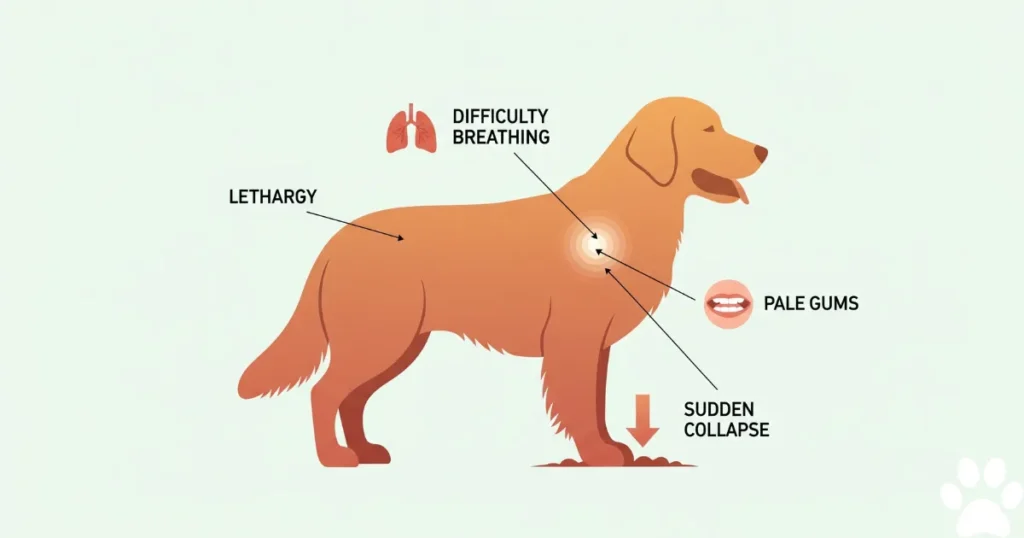
What does a cancerous tumor look like on a Golden Retriever?
Cancerous tumors can vary significantly in appearance, but warning signs include rapid growth, irregular shapes, ulceration, bleeding, or tumors that feel firmly attached to underlying tissues. Unlike benign fatty tumors that are soft and moveable, malignant tumors often feel harder and may be fixed in place.
How quickly do tumors grow in Golden Retrievers?
Tumor growth rates vary dramatically depending on the type. Benign tumors like lipomas may grow slowly over months or years, while aggressive cancers like hemangiosarcoma can develop and spread rapidly within weeks. Any rapidly growing mass should be evaluated immediately by a veterinarian.
Can I tell if my Golden Retriever’s tumor is benign or malignant just by looking?
Visual examination alone can not definitively determine if a tumor is benign or malignant. While certain characteristics may suggest one type over another, professional diagnostic testing, including fine needle aspiration or biopsy, is necessary for accurate diagnosis.
Are Golden Retrievers more prone to certain types of tumors?
Yes, Golden Retrievers have genetic predispositions to several cancer types, including hemangiosarcoma (blood vessel cancer), lymphoma, osteosarcoma (bone cancer), and mast cell tumors. This breed’s higher cancer incidence makes regular monitoring especially important.
Should I be worried about every lump I find on my Golden Retriever?
While not every lump is cancerous, all new growths should be evaluated by a veterinarian. Many lumps in Golden Retrievers are benign fatty tumors (lipomas), but proper diagnosis is essential to rule out malignant conditions and ensure appropriate monitoring or treatment.
What’s the difference between a tumor and a cyst in dogs?
Cysts are typically fluid-filled sacs that may feel softer and more moveable than solid tumors. They often have a visible opening or may leak fluid when pressure is applied. Tumors are solid masses of abnormal tissue growth. However, a professional examination is needed to distinguish between the two accurately.
At what age should I start worrying about tumors in my Golden Retriever?
While tumors can occur at any age, the risk increases significantly after age 7-8 years in Golden Retrievers. However, younger dogs can also develop tumors, so regular monitoring should begin early and continue throughout your dog’s life.
How often should I check my Golden Retriever for tumors?
Perform monthly at-home examinations by running your hands over your dog’s entire body. Additionally, maintain regular veterinary checkups every 6-12 months, with more frequent visits for senior dogs or those with a previous tumor history.
Final Thoughts
Understanding what does a tumor look like on a dog and recognizing tumor symptoms in dogs can literally be life-saving knowledge for Golden Retriever owners. Throughout this comprehensive guide, we’ve explored the visual characteristics of various tumor types, from benign lipomas to aggressive malignancies like hemangiosarcoma and melanomas. The ability to identify these growths early significantly improves treatment outcomes and your dog’s quality of life.
Golden Retrievers face unique challenges when it comes to cancer, with their genetic predisposition making vigilant monitoring essential rather than optional. However, this increased awareness shouldn’t cause panic or anxiety. Instead, it should empower you to become your dog’s best health advocate through regular examinations, proper nutrition, environmental safety measures, and strong veterinary partnerships.
Remember that not every lump or bump indicates cancer. Many growths in Golden Retrievers are benign fatty tumors or cysts that pose little threat to your dog’s health. The key lies in the professional evaluation of any new or changing masses, as visual examination alone can not definitively determine malignancy. Early detection through consistent monitoring, combined with prompt veterinary attention when concerns arise, provides the best foundation for positive outcomes.
The journey of signs of cancer in dogs and tumor symptoms in dogs recognition doesn’t end with this guide. Continue educating yourself about your Golden Retriever’s health needs, maintain regular veterinary relationships, and trust your instincts when something seems different about your beloved companion. Your dedication to understanding tumor identification and prevention strategies demonstrates the deep love you have for your Golden Retriever, and that commitment to their wellbeing is the most powerful tool in their health arsenal.
Whether you’re dealing with a current health concern or simply preparing to be the best possible pet parent, the knowledge you’ve gained here will serve you well throughout your Golden Retriever’s life. Stay vigilant, stay informed, and remember that many dogs with tumor diagnoses go on to live happy, fulfilling lives with proper care and treatment.
Dr. Nabeel A.
Hi, I’m Dr. Nabeel Akram – a farm management professional by trade and a passionate Golden Retriever enthusiast at heart. With years of experience in animal science and livestock care, I’ve built a career around understanding animals—how they live, thrive, and bring value to our lives. This blog is a personal project born from that same passion, focusing on one of the most loyal and lovable breeds out there: the Golden Retriever. Whether I’m managing farm operations or sharing insights on canine health, behavior, and care, it all ties back to one core belief—animals deserve thoughtful, informed, and compassionate attention. Welcome to a space where professional expertise meets genuine love for dogs.
Facebook |
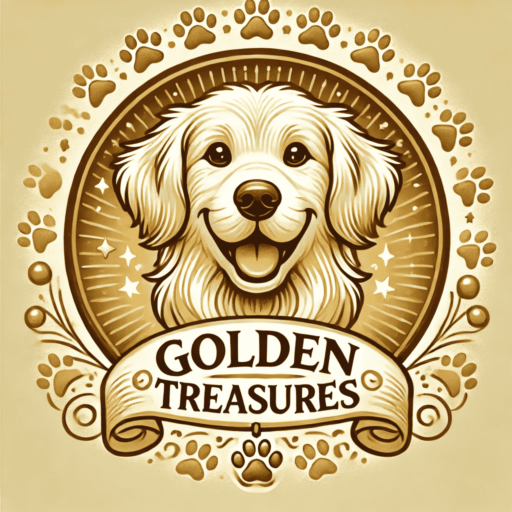

Links will be automatically removed from comments.